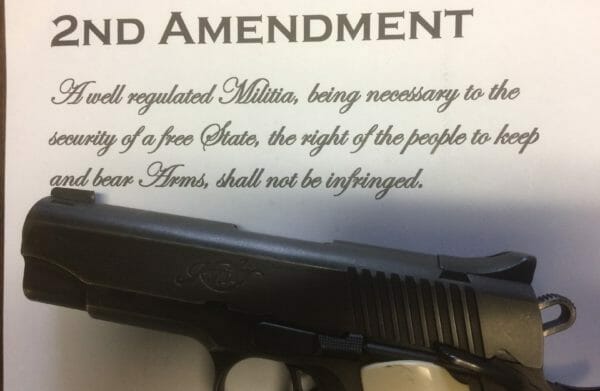
U.S.A. — In the recent series of direct Supreme Court opinions on what rights the Second Amendment protects, the Court laid out a brilliant exposition of what the words of the Second Amendment mean and how to use the meaning of the Second Amendment in judging the law. Those cases started with Heller, continued with McDonald, with more in Caetano, and most recently with Bruen. Earlier decisions talked about the Second Amendment without ruling on it directly at the Supreme Court. The famous Miller decision from 1939 is muddy and does not give a definitive interpretation.
Justice Thomas of the Supreme Court is an originalist and a textualist. This means he judges the law by the text of the Constitution instead of determining what results he desires or what he thinks is the best policy for the country. Progressive judges do not do this. They look to the results they wish, then work to find out a way to justify those results. The idea of a “living constitution,” in essence, means no effective Constitution.
The Constitution is a contract between the Federal Government, the People, and the States. It specifies and arranges the political power structure of the Republic. It is detailed and easily understandable by people of ordinary intelligence. The writers of the Constitution understood political philosophy and the nature of man extremely well, much better than most contemporary politicians.
The modern Progressive movement arose in the 1890s, pushed by those who wanted more power to make national laws they believed to be necessary. Many desired to make the nation stronger, to “right wrongs,” and “do good.” They may have meant to be benevolent rulers, but they meant to rule. They despised the restrictions placed on their ambitions by the structure of the Constitution and the Bill of Rights. Most of their argument for ignoring the Constitution or finding ways to “workaround” the structure it imposed consisted of two themes.
- Everything changes over time. Nothing is immutable. The principles of human nature and political thought the Constitution was constructed on are not valid now because human nature and political thought have changed.
- That was then. This is now. The Constitution restricts what we have to do to prosper in modern times. Therefore we have to either ignore the Constitution or find ways to work around it.
The idea of a means-ends test to determine what the Constitution means is pure Progressive ideology.
Instead of determining what the Constitution meant at the time it was ratified, the means-ends test looks at the results of a Constitutional interpretation and determines if the results are what was desired by the legislature or what is desired by the judges’ will. Means-end is pure case-by-case pragmatism or power politics. Its guiding star is: Does this decision do what the judge (or legislature) wants to get done?
Textualism and Originalism reject interpreting the Constitution to obtain the desired policy decision. Instead, to determine the fine points of what the Constitution means in a particular circumstance, you start with the text of the Constitution and the Bill of Rights. The text is the most important part. Then, to be sure you are not imparting meaning to the words you desire them to have, you examine their meaning when the Constitution and the Bill of Rights were ratified. The text, with the words’ meaning at the time of ratification, is the standard.
For the Second Amendment, this was spelled out in the 2008 Heller decision and elaborated on in later decisions, particularly in Bruen. From District of Columbia v. Heller, 2008:
The Second Amendment provides: “A well regulated Militia, being necessary to the security of a free State, the right of the people to
keep and bear Arms, shall not be infringed.” In interpreting this text, we are guided by the principle that “[t]he Constitution was written to
be understood by the voters; its words and phrases were used in their normal and ordinary as distinguished from technical meaning.” United States v. Sprague, 282 U. S. 716, 731 (1931); see also Gibbons v. Ogden, 9 Wheat. 1, 188 (1824). Normal meaning may of course include an idiomatic meaning, but it excludes secret or technical meanings that would not have been known to ordinary citizens in the founding generation.
In Heller, the structure of the Second Amendment was examined closely. The Amendment consists of two parts; the prefatory clause (A well regulated Militia, being necessary to the security of a free State,) and the operative clause (the right of the people to keep and bear Arms, shall not be infringed). The prefatory clause gives one reason for the purpose of the Amendment. It is not exclusionary. One reason does not exclude other reasons. The prefatory clause does not control or limit the operative clause. Such structure was common in the language of 1791 and earlier. Several state constitutions of the time use similar structure. The operative clause indicates the the right is a pre-existing right exercised by individuals. The justices in the Heller decision unanimously agreed the Second Amendment refers to a pre-existing right exercised by individuals.
The primary question of interpretation was what does “the right of the people to keep and bear arms” mean? While the Heller dissenters argued it meant the right of individuals to participate in militias, the overwhelming evidence was it meant, at the time, a broad array of rights exercised and expanded in the colonies, derived, in part, from the English right to arms, which individuals exercised. The extent and limits to the right to keep and bear arms at the time of the ratification of the Bill of Rights require a look at what they were broadly understood to mean by the body of the people at the time the Bill of Rights was ratified. It is impossible to determine what may not be infringed if you do not know what the right to keep and bear arms meant at the time. The Bruen decision rejects the means-ends test. From NYSR&PA v. Bruen:
(1) Since Heller and McDonald, the Courts of Appeals have developed a “two-step” framework for analyzing Second Amendment challenges that combines history with means-end scrutiny. The Court rejects that two-part approach as having one step too many. Step one is broadly consistent with Heller, which demands a test rooted in the Second Amendment’s text, as informed by history. But Heller and McDonald do not support a second step that applies means-end scrutiny in the Second Amendment context. Heller’s methodology centered on constitutional text and history. It did not invoke any means-end test such as strict or intermediate scrutiny, and it expressly rejected any interest-balancing inquiry akin to intermediate scrutiny. Pp. 9–15.
In Bruen, it is explained why historical analysis is the standard instead of means-ends-interest balancing. Determining the historical meaning of the Amendment is no more demanding than attempting to balance interests. For the Bill of Rights, interest balancing is off the table. Interest balancing gives judges power they are not granted by the Constitution. Only historical analysis is appropriate.
(2) Historical analysis can sometimes be difficult and nuanced, but reliance on history to inform the meaning of constitutional text is more legitimate, and more administrable, than asking judges to “make difficult empirical judgments” about “the costs and benefits of firearms restrictions,” especially given their “lack [of] expertise” in the field. McDonald, 561 U. S., at 790–791 (plurality opinion). Federal courts tasked with making difficult empirical judgments regarding firearm regulations under the banner of “intermediate scrutiny” often defer to the determinations of legislatures. While judicial deference to legislative interest balancing is understandable—and, elsewhere, appropriate—it is not deference that the Constitution demands here. The Second Amendment “is the very product of an interest balancing by the people,” and it “surely elevates above all other interests the right of law-abiding, responsible citizens to use arms” for self-defense. Heller, 554 U. S., at 635. Pp. 15–17.
In Bruen, the idea of “that was then, this is now” is expressly addressed. The Caetano decision unanimously concluded arms that did not exist at the time of the ratification are protected if they are “bearable arms” and “in common use”.
(3) The test that the Court set forth in Heller and applies today requires courts to assess whether modern firearms regulations are consistent with the Second Amendment’s text and historical understanding. Of course, the regulatory challenges posed by firearms today are not always the same as those that preoccupied the Founders in 1791 or the Reconstruction generation in 1868. But the Constitution can, and must, apply to circumstances beyond those the Founders specifically anticipated, even though its meaning is fixed according to the understandings of those who ratified it. See, e.g., United States v. Jones, 565 U. S. 400, 404–405. Indeed, the Court recognized in Heller at least one way in which the Second Amendment’s historically fixed meaning applies to new circumstances: Its reference to “arms” does not apply “only [to] those arms in existence in the 18th century.” 554 U. S., at 582.
There may have to be some adaptation by analogy to deal with changed technology. From Bruen:
To determine whether a firearm regulation is consistent with the Second Amendment, Heller and McDonald point toward at least two relevant metrics: first, whether modern and historical regulations impose a comparable burden on the right of armed self-defense, and second, whether that regulatory burden is comparably justified. Because “individual self-defense is ‘the central component’ of the Second Amendment right,” these two metrics are “ ‘central’ ” considerations when engaging in an analogical inquiry. McDonald, 561 U. S., at 767 (quoting Heller, 554 U. S., at 599).
The right to keep and bear arms was not understood as unlimited at the time of ratification.
Automobiles did not exist when the Bill of Rights was ratified. The closest analogy would be travel by horse or horse-drawn vehicles. At the time of ratification, there were no restrictions on the carry of weapons by individuals on horses or horse-drawn vehicles, unless the mounted individuals were carrying the weapons so as to terrify the population. Weapons that were unusual and particularly dangerous were prohibited from display if they terrified the population. The modern analogy would be drive-by shootings, or menacing people with weapons while in an automobile. It may mean having a ring-mounted machine gun on a pickup truck, with an operator ready to fire it, could be prohibited. Common weapons available and ready to use while traveling were specifically protected in several laws of the era.
At the time of ratification, it was understood the carrying of weapons could be prohibited in legislative assemblies, polling places, or in court rooms. These were “sensitive places” at the time of ratification. To expand “sensitive places” to all public places is unacceptable. It was acceptable to disarm prisoners and to keep them disarmed. The right to keep arms did not include the right to steal arms if you did not possess arms of your own. It included the right to buy or make arms of your own.
To claim all weapons laws are void because the Second Amendment includes the words “shall not be infringed” is not correct. It depends on what the “right to keep and bear arms” meant to the people at the time of ratification. To conclude otherwise is to place the interpretation of the Second Amendment in the hands of modern readers, without regard to the historical record.
The restrictions on the right to keep and bear arms at the time of ratification were far fewer than exist today. Infringements on the right to keep and bear arms have accumulated over the last century and a half. Those infringements are being rolled back in the courts. The Bruen decision gives the courts the proper test to determine if a law is acceptable under the Second Amendment.
To claim historical analysis of laws at the time of the ratification is more difficult than balancing interests in the modern era is a ruse to place enormous power in the hands of judges, power which was never granted to them by the Constitution.
About Dean Weingarten:
Dean Weingarten has been a peace officer, a military officer, was on the University of Wisconsin Pistol Team for four years, and was first certified to teach firearms safety in 1973. He taught the Arizona concealed carry course for fifteen years until the goal of Constitutional Carry was attained. He has degrees in meteorology and mining engineering, and retired from the Department of Defense after a 30 year career in Army Research, Development, Testing, and Evaluation.







Once upon a time….. Christians who were not fluent in Latin or Greek had to depend on priests educated by the Roman Catholic or Eastern Orthodox churches to interpret the scripture for them. What they heard was what the establishment wanted them to hear. There was a tight interrelation between the power structures of the church and the political leadership that influenced what the people were told. That changed forever when, from 1522 to 1544, Martin Luther printed a translation of the original Hebrew, Greek and Aramaic texts into German. Finally, people could read for themselves what had been heavily… Read more »
In regards to the word “State” The orinignal writting of the 2nd Amendment, the S is not capitalized. I believe that the small s indicates a state of mind not the State of Connecticut or any other State. A free state of mind is different that a free State.
“As civil rulers, not having their duty to the people before them, may attempt to tyrannize, and as the military forces which must be occasionally raised to defend our country, might pervert their power to the injury of their fellow citizens, the people are confirmed by the article in their right to keep and bear their private arms.” (Tench Coxe in ‘Remarks on the First Part of the Amendments to the Federal Constitution’ under the Pseudonym ‘A Pennsylvanian’ in the Philadelphia Federal Gazette, June 18, 1789 at 2 col. 1) “Who are the militia? Are they not ourselves? Is it… Read more »
An armed honest citizen is a polite citizen and I am very comfortable with that said citizen in my presence whether in a court of law or anywhere else. As a matter of fact, I would enjoy knowing that citizen was armed in a Sensitive place. If I were a judge in the court I would be honored to have an armed citizen in my court. I am a very simple minded person and the only sensitive place I can think of right now is my rear end because I have Hemorrhoids. Agree with me or not if you are… Read more »
No doubt the Miller case was a one sided briefed argument before the Court. That very government which expounds its purposes is to protect our Rights, steals them daily. You can bet your backside if Miller was briefed only by Miller, the scum that by their own admittance had no idea what the NFA would do, they would scream to high heaven the injustice, but they cared less about Miller, pushing for their infringement to be upheld by the Court, the NFA. The Miller Court failed Miller, America and the very Constitution they swore to uphold. Anyone know why suppressors… Read more »
“…the modern era is a ruse to place enormous power in the hands of judges, power which was never granted to them by the Constitution.”
Hear Hear! The courts long ago over stepped their Constitutional powers and must be brought to heel.